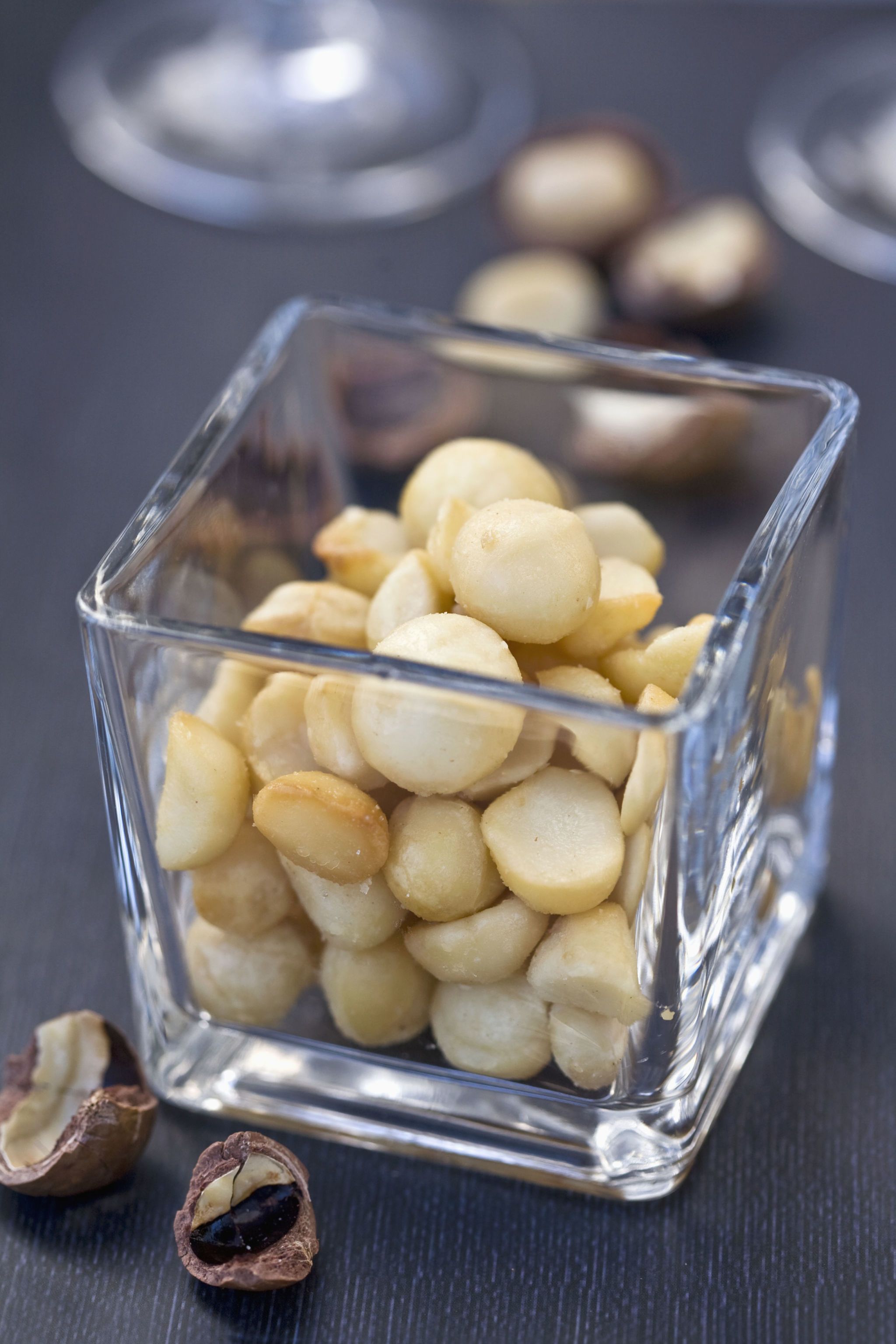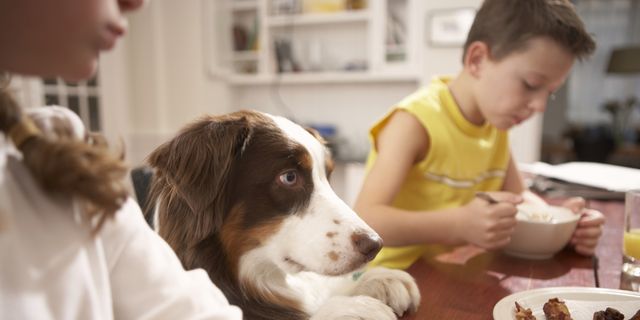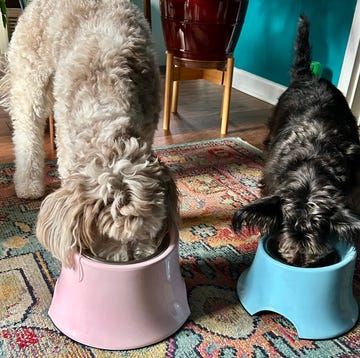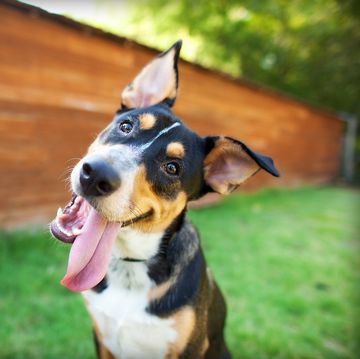1Cooked Bones
 Getty Images
Getty ImagesWhy they're bad: Don’t let your pup into the rotisserie chicken. "The cooking process makes bones more brittle than when they are raw, making them more likely to splinter when a dog chews them," says Dr. Danielle Bernal, a veterinarian with Wellness Natural Pet Food. They can cause choking or worse, perforate your dog’s intestine.
Worst-case scenario: Potential outcomes include broken teeth, mouth injuries, constipation and, most concerningly, a blockage or perforation in the intestinal tract. That can also cause peritonitis, or inflammation around the stomach tissue.
2Dairy
 Westend61//Getty Images
Westend61//Getty ImagesWhy it's bad: Most dogs are lactose-intolerant, says veterinarian Sonja Olson. Just like in people who have this condition, eating things like milk, cheese, and ice cream can lead to a variety of stomach issues. While lactose-intolerant people can take a dairy pill to enjoy some ice cream, dogs should be kept away from it.
Worst-case scenario: Subsequent vomiting, diarrhea, and other gastrointestinal problems may require hospitalization.
RELATED: Cutest Dog Breeds
Advertisement - Continue Reading Below
3Macadamia Nuts
 Martina Schindler//Getty Images
Martina Schindler//Getty ImagesWhy they're bad: Macadamia nuts can be toxic and also have a high fat content that can irritate dogs' stomachs. According to veterinarian Justine Lee, a dose of about two nuts per pound of a dog's body weight can result in poisoning that can lead to a temporary inability to walk.
Worst-case scenario: In addition to paralysis, dogs can suffer severe weakness, nausea and diarrhea that requires hospitalization.
4Leeks, Onions, and Garlic
 Foodcollective//Getty Images
Foodcollective//Getty ImagesWhy they're bad: These seasonings may be delicious for people, but they are dangerous to dogs. Foods that are part of the allium family can injure dogs' red blood cells, meaning they can make the dog anemic, explains Dr. Lee. They're only a serious issue, however, when eaten raw and in large amounts.
Worst-case scenario: Dogs can get hemolytic anemia, which requires a hospital trip. To make matters more complicated, it can take a few days before the anemia is revealed, Dr. Lee notes.
RELATED: Largest Dog Breeds
Advertisement - Continue Reading Below
5Bacon
 Getty Images
Getty ImagesWhy it's bad: You probably don't feel great after inhaling a plate of bacon, but it's even worse for your pooch. This breakfast treat contains high levels of sodium and fat that can lead to upset stomach or even pancreatitis (an inflamed pancreas that functions incorrectly) in dogs.
Worst-case scenario: Diarrhea, vomiting, pancreatitis and sodium ion poisoning may occur.
6Raw Dough
 Getty Images
Getty ImagesWhy it's bad: Keep an eye on your sourdough. The yeast in unbaked bread can cause life-threatening illnesses after it's ingested. "The dough continues to rise in their stomach and can extend their entire abdomen, causing extreme pain and potential blockages in the intestinal tract," Dr. Bernal says.
Worst-case scenario: This effect may lead to a twisting of the stomach known as gastric-dilation volvulus. Another potential complication: The fermentation of the raw dough produces ethanol, which can lead to alcohol poisoning.
Advertisement - Continue Reading Below
7Avocados
 Westend61//Getty Images
Westend61//Getty ImagesWhy they're bad: These popular fruits are dangerous for two reasons. First, they have a high fat content, which can wreak havoc on your dog's tummy. Second, the slippery, hard pit is easy to swallow and can lead to choking or a gastrointestinal obstruction, Dr. Lee notes.
Worst-case scenario: Your dog can choke on the pit, or surgery might be required to remove a gastrointestinal blockage.
RELATED: Best Hypoallergenic Dog Breeds
8Peaches and Plums
 David Solzberg//Getty Images
David Solzberg//Getty ImagesWhy they're bad: Small amounts of only the flesh of stone fruit won't cause a problem for your dog, but large amounts can cause stomach upset. And you should never let your dog have stone fruit pits, which can be a choking hazard and can also cause cyanide poisoning.
Worst-case scenario: Like avocados, the pit can get lodged in a dog's throat or stomach, leading to choking and gastrointestinal obstructions that can be fatal. They can also release cyanide inside your dog's stomach, poisoning them.
Advertisement - Continue Reading Below
9Corn on the Cob
 Thomas Barwick//Getty Images
Thomas Barwick//Getty ImagesWhy it's bad: While corn itself isn't toxic to dogs, it can become a major hazard because the cob (even just a few inches of it) is the perfect size to get stuck in the intestinal tract. What's more, corn cobs are notoriously hard to see on x-rays and doctors may have to find it with an ultrasound, Dr. Lee explains.
Worst-case scenario: Without surgery to remove the corn cob, this can be fatal.
10Chocolate
 Westend61//Getty Images
Westend61//Getty ImagesWhy it's bad: This sweet treat contains compounds like caffeine that can lead to vomiting, dehydration, abdominal pain, muscle tremors, irregular heart rhythm, seizures and death.
Worst-case scenario: Dr. Lee recalls a horror story of a pug who died after eating 8 ounces of semi-sweet baker's chocolate. "The owners didn't bring the dog in until 24 hours later, when the dog had profuse diarrhea and vomiting." Unfortunately, it was too late.
RELATED: Best Couch Covers for Dogs
Advertisement - Continue Reading Below
11Grapes and Raisins
 Bronze Photography//Getty Images
Bronze Photography//Getty ImagesWhy it's bad: Grapes and raisins (as well as some cranberries and currants) can cause rapid kidney failure in dogs. It's also easy to forget how many foods in your kitchen can contain these culprits, such as trail mix, cookies and Raisin Bran.
Worst-case scenario: "I've seen dogs that have had only a couple of raisins go into horrible kidney failure and have to be hospitalized for days," Dr. Lee says. Without proper treatment, this can be fatal.
12Alcohol
 Lew Robertson//Getty Images
Lew Robertson//Getty ImagesWhy it's bad: Dogs are more sensitive to intoxication effects, explains Dr. Olson, who encourages pet owners to think of their dogs like children when it comes to liquor. "Their enzymes are similar to ours, but the effects of alcohol are more potent." She notes that dogs gravitate toward sweet, mixed drinks that mask the smell of alcohol.
Worst-case scenario: Just like humans, dogs can suffer from alcohol poisoning, which will require medical treatment.
Advertisement - Continue Reading Below
13Coffee
 Daniel J. Grenier//Getty Images
Daniel J. Grenier//Getty ImagesWhy it's bad: Coffee acts like a stimulant in dogs and causes an increased heart rate, panting, heart arrhythmia, high blood pressure, tremors and seizures. "Chocolate-covered espresso beans are a double-whammy," Dr. Olson notes.
Worst-case scenario: Seizures may cause secondary complications that can lead to death.
RELATED: Old Lady Dog Names That Are So Vintage
14Sugar-Free Gum or Candy
 Getty Images
Getty ImagesWhy it's bad: Nearly all sugar-free or low-calorie candies contain xylitol, a sugar substitute. It causes dogs' insulin levels to spike as well as serious liver problems. The most common culprit vets see? Sugar-free gum inside a purse on the floor. A tip: If xylitol is listed in the first three to five ingredients, it's typically poisonous for pups.
Worst-case scenario: Xylitol can lead to insulin spikes, low blood sugar, liver failure and even death.
Advertisement - Continue Reading Below
15White Bread
 Louise Lister//Getty Images
Louise Lister//Getty ImagesWhy it's bad: Commercial white bread has tons of oil and sugar in it, which can cause pancreatitis in dogs. Schnauzers are particularly susceptible, Dr. Olson notes, adding that she treated one who had eaten an entire loaf of white bread. "He was so sick," she recalls. "He was in the hospital for days."
Worst-case scenario: Eating too much can cause severe pancreatitis and require a variety of medical treatments and hospitalization.
16Salty Snacks
 Getty Images
Getty ImagesWhy they're bad: A single chip will likely only cause them to drink more water, but just like in humans, an overdose on salt can take its toll on dogs.
Worst-case scenario: Large amounts of sodium can cause serious issues like tremors and seizures, Dr. Bernal says.

Elizabeth Durand Streisand was a former freelance journalist with bylines in Us Weekly, Yahoo, Life & Style, NY Post, NY Daily News, and MTV, among others. She’s currently the CEO of Broadway Roulette.

Caroline is a writer and editor with almost a decade of experience. From 2015 to 2019, she held various editorial positions at Good Housekeeping, including as health editor, covering nutrition, fitness, wellness, and other lifestyle news. She's a graduate of the Medill School of Journalism and dreams of the day Northwestern will go back to the Rose Bowl.
Advertisement - Continue Reading Below
Readers Also Read
Advertisement - Continue Reading Below
Advertisement - Continue Reading Below































